Abstract
In contrast to traditional fixed-accuracy transaction level models, the abstraction level of accuracy-adaptive models can be changed during simulation. This enables dynamic trade-off between simulation performance and accuracy. In this article we present a modeling style for systematic construction of accuracy-adaptive models. Additionally, we present the simulation semantics of those models in an abstract and rigorous manner which is independent of implementation language and simulation algorithm. This abstract formulation allows different sequential and parallel simulation schemes to be studied and compared. Based on the presented semantics, we present a high-performance parallel simulation scheme which offers considerable improvement over the performance of existing parallel simulation schemes.




























Similar content being viewed by others
References
Beltrame G, Sciuto D, Silvano C (2007) Multi-accuracy power and performance transactions-level modeling. IEEE Trans Comput-Aided Des Integr Circuits Syst. doi:10.1109/TCAD.2007.895790
Breuer PT, Fernández LS, Kloos CD (1995) A simple denotational semantics, proof theory and a validation condition generator for unit-delay VHDL. Formal Methods Syst Des. doi:10.1007/BF01383872
Chopard B, Combes P, Zory J (2006) A conservative approach to SystemC parallelization. In: Proceedings of the international conference on computational science (ICCS 2006)
Combes P, Caron E, Desprez F, Chopard B, Zory J (2008) Relaxing synchronization in a parallel SystemC kernel. In: Proceedings of the international symposium on parallel and distributed processing with applications (ISPA’08)
Doemer R, Gerstlauer A, Gajski D (2002) The SpecC language reference manual, version 2.0. SpecC Technology Open Consortium
Fujimoto RM (1990) Parallel discrete event simulation. Commun ACM 33:30–53. doi:10.1145/84537.84545. http://doi.acm.org/10.1145/84537.84545
Fujimoto RM (1999) Exploiting temporal uncertainty in parallel and distributed simulations. In: Proceedings of the thirteenth workshop on parallel and distributed simulation, PADS’99. IEEE Computer Society, Washington, pp 46–53. http://dl.acm.org/citation.cfm?id=301429.301457
Hines K, Borriello G (1997) Dynamic communication models in embedded system co-simulation. In: Proceedings of the 34th annual conference on design automation (DAC’97), pp 395–400
Huang K, Bacivarov I, Hugelshofer F, Thiele L (2008) Scalably distributed SystemC simulation for embedded applications. In: Proceedings of the international symposium on industrial embedded systems (SIES’2008)
IEEE Computer Society (2006) Standard SystemC language reference manual. Standard 1666-2005
Karner M, Armengaud E, Steger C, Weiss R (2010) Holistic simulation of flexray networks by using run-time model switching. In: Proceedings of the conference on design, automation and test in Europe, DATE’10. European design and automation association, 3001 Leuven, Belgium, pp 544–549. http://portal.acm.org/citation.cfm?id=1870926.1871054
Karner M, Steger C, Weiss R, Armengaud E (2009) Optimizing hw/sw co-simulation based on run-time model switching. In: Forum on specification design languages, 2009, FDL 2009, pp 1–6
Loper ML, Fujimoto RM (2004) Exploiting temporal uncertainty in process oriented distributed simulations. In: Proceedings of the 36th conference on winter simulation (WSC’04)
Mello A, Maia I, Greiner A, Pecheux F (2010) Parallel simulation of SystemC TLM 2.0 compliant MPSoC on SMP workstations. In: Proceedings of the conference on design, automation and test in Europe (DATE’10)
Misra J (1986) Distributed discrete-event simulation. Comput Surv. doi:10.1145/6462.6485
MPI Forum (2012) MPI: a message-passing interface standard. http://www.mpi-forum.org/
Open SystemC Initiative (OSCI) (2009) TLM working group (www.systemc.org): OSCI TLM-2.0 language reference manual and library
Radetzki M, Salimi Khaligh R (2008) Accuracy-adaptive simulation of transaction level models. In: Proceedings of design, automation and test in Europe 2008 (DATE 08)
Rosenblum M, Herrod S, Witchel E, Gupta A (1995) Complete computer system simulation: the SimOS approach. IEEE Parallel Distrib Technol 3(4):34–43
Salimi Khaligh R, Radetzki M (2008) A latency, preemption and data transfer accurate adaptive transaction level model for efficient simulation of pipelined buses. In: Proceedings of forum on specification and design languages (FDL’08), Stuttgart, Germany
Salimi Khaligh R, Radetzki M (2009) Adaptive interconnect models for transaction-level simulation. In: Languages for embedded systems and their applications (LNEE 36)
Salimi Khaligh R, Radetzki M (2009) Efficient parallel transaction level simulation by exploiting temporal decoupling. In: Proceedings of the international embedded systems symposium (IESS’09)
Salimi Khaligh R, Radetzki M (2010) A dynamic load balancing method for parallel simulation of accuracy adaptive TLMs. In: Proceedings of forum on specification and design languages (FDL’10)
Salimi Khaligh R, Radetzki M (2010) Modelling constructs and kernel for parallel simulation of accuracy adaptive TLMs. In: Proceedings of the conference on design, automation and test in Europe (DATE’10)
Salimi Khaligh R, Radetzki M (2011) A metamodel and semantics for transaction level modeling. In: Proceedings of forum on specification and design languages (FDL’11), Oldenburg, Germany
Schumacher C, Leupers R, Petras D, Hoffmann A (2010) PARSC: synchronous parallel SystemC simulation on multi-core host architectures. In: 2010 IEEE/ACM/IFIP international conference on hardware/software codesign and system synthesis (CODES+ISSS), pp 241–246
The Embedded Microprocessor Benchmark Consortium (EEMBC) (2012) Multicore benchmark software (multibench) 1.0. http://www.eembc.org
Winskel G (1993) The formal semantics of programming languages: an introduction. MIT Press, Cambridge
Acknowledgements
This work is funded by the German Research Foundation (Deutsche Forschungsgemeinschaft—DFG) under grant Ra 1889/1-1.
Author information
Authors and Affiliations
Corresponding author
Rights and permissions
About this article
Cite this article
Salimi Khaligh, R., Radetzki, M. Semantics and efficient simulation of accuracy-adaptive TLMs. Des Autom Embed Syst 16, 1–29 (2012). https://doi.org/10.1007/s10617-012-9095-9
Received:
Accepted:
Published:
Issue Date:
DOI: https://doi.org/10.1007/s10617-012-9095-9




